 St John's Church Watford
St John's Church Watford
The History of St John's Church

The first church, 1873
The current building, 1893
A parish church, 1904
Restoration in the 1960s
The 21st century
The first church, 1873
Watford was for many centuries an agricultural community with some cottage industry. Its parish church of St Mary the Virgin, built in 1230 on the same site as an earlier Saxon church, served the small population well.
In the 19th Century, brewing, printing and the railway (which began with a staff of eleven) started the growth of the town. Another church was needed for the newly developing area, and St Andrew's was dedicated in 1856. Watford now had two parish churches.
In 1871, the ancient parish church of St Mary was extensively restored. The building could not be used for worship while the work was in progress, so a temporary iron building was erected in the churchyard. When St Mary's was re-opened, this iron building was no longer required. Some ground in Sotheron Road (now called Sutton Road) was given to the churchwardens of St Mary's for use as a site for a new church. The iron building was moved to this site, and on the 23rd November 1873, St John's began.
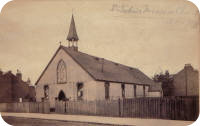
> The Tin Church, which served the area from 1873-1893.
The current building, 1893
The total population of Watford at this time was less than 8,000. The first priest-in-charge of St John's was the Reverend J. Henry White. This temporary building, with seating for 450, was affectionately known as "The Tin Church". It attracted a growing number of people, and was considered very 'High Church' for its day - many of the things that we associate with catholic worship were yet to come, however. The roof of the Tin Church was unfortunately not waterproof, and it was quickly apparent inside when it was raining outside! The idea of a permanent building was mooted, and there followed a period of great activity to raise the necessary money.
The design for the church was ambitious, with lofty nave and chancel inside, and imposing tower and spire which would be visible from throughout Watford.
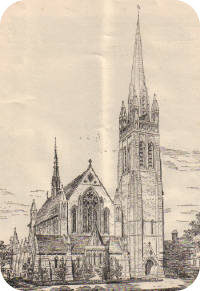
> A drawing showing the original design with tower and spire.
Many people were most generous - more land was given, plans were drawn up and approved and eventually the foundation stone was laid on 17th July 1891. Two years and two days later, on 19th July 1893, Wogan Festing, Lord Bishop of St Albans, dedicated the fine building. It cost £m11,000 to build - a huge sum in those days. The building, as dedicated in 1893, did not fully match the architect's original plans - the tower and spire were not completed, presumably due to lack of funds - in their place a more modest belfry stands.
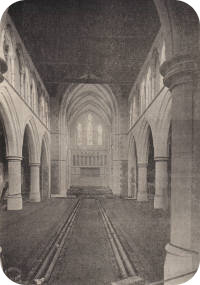
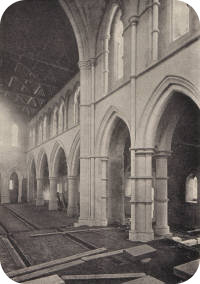
> Two views of the church interior during construction.

> View of the church exterior in 1893, still surrounded by construction hoarding.
A parish church, 1904
In May 1904 St John's became a parish church in its own right. Fr James (appointed priest-in-charge in 1898) became the first Vicar. Watford, with a population approaching 35,000, now had three parish churches.
St John's has always been considered to be one of the leading anglo-catholic churches in the South of England. Many things which are now taken for granted were considered then to be dangerous innovations - wafer breads and vestments were introduced in 1904. Four years later, on the Feast of the Epiphany, incense was used for the first time.
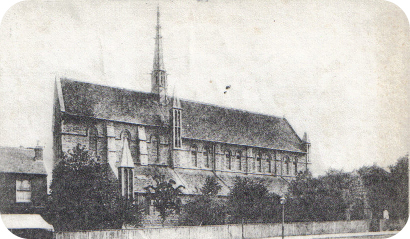
> View of the church exterior taken on 19th August 1906.
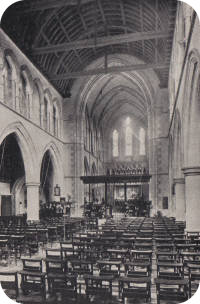
> View of the interior, showing the first screen dividing the nave and chancel. This screen remained in place until 1908.
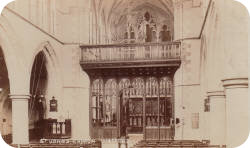
> View of the interior in 1908 shortly after installation of the magnificent new screen, which remains in place to this day.
Fr James, later Canon James, but called affectionately behind his back 'Reggie James', was vicar of St John's for fifty years, helped - as he himself has said - by many fine assistant priests. He served the parish well through the heartbreaking years of two world wars. In the 1914-18 war, all the choirmen joined up, and all, save one, were killed in action. Canon James officiated at the weddings of many youngsters he had baptised. In the 1950s, he saw to the building of a Vicarage for St John's, and in 1954 he resigned, seeing the Cure (ie, the care) of Souls pass to the Reverend S.J.Forrest, a former assistant priest.
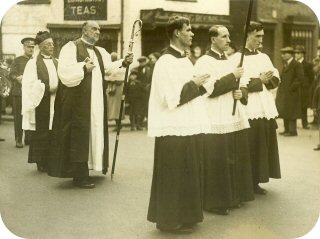
> Canon Reginald James, first vicar of St John's, assists Bishop Furze, Bishop of St Albans during a procession in High Street, Watford. Canon James is just behind the Bishop. The crucifer (Reginald Norton) and two servers (Bernard Hudson and Peter Hudson (?) ) were also members of St John's. The exact date of the photograph is not known, but it is believed to date from 1932-1935
Fr John Forrest is perhaps better known as a writer of poetry centered around the church, and the seventh Station of the Cross at the Shrine of Our Lady of Walsingham is dedicated to him.
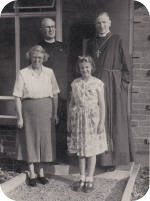
> The Bishop of St Alban's visits the new Vicarage. Pictured are the Bishop, Fr. S.J.Forrest and his family.
St John's has a fine organ built in 1911, when the foundation stone of the church hall was also laid. Many gifts of fine plate silver, vestments, copes, stations of the cross, crib figures, Madonna statue, glass, and woodwork have been received over the years.
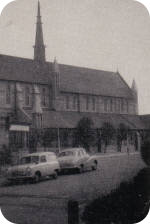
> View of the church exterior in 1959, showing the tree lined north face of the building.
Restoration in the 1960s
In more recent times, much has been done to repair and restore the church inside and out. Much maintenance work has to be left undone during the war and the years of restriction which followed. The restoration, beginning with the cleaning of the chancel and sanctuary, had just been put in hand when Fr Forrest resigned in 1961. The Reverend Richard Salter was inducted as St John's third Vicar at the beginning of 1962. The nave and aisles were cleaned and redecorated in memory of Canon James who died in 1966. The cleaning and repair of outside stonework was done in 1973 for the church's centenary. Fr Richard Salter left the church in 1998, and in the following year Fr James Cope was inducted as the fourth Vicar.
The 21st century
In 2007 Fr James left to become the incumbent at the Parish Church of St Cuthbert of Lindisfarne, Castle Vale, Birmingham. During the interregnum St John's was blessed to be cared for by Father Edward Lewis, Chaplain to Her Majesty The Queen. On 25th March 2010, Fr Edward was licensed as Parish Priest of St John's, on a half time basis; he left in 2011, and was inducted as Vicar of St Mary's Kenton by The Rt Reverend Peter Wheatley, on 20th May 2011.
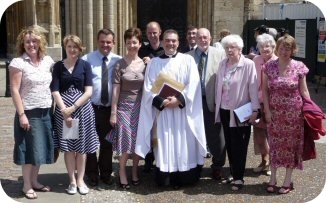
> Fr David Stevenson surrounded by friends at his ordination as a Deacon in Norwich Cathedral, 28th June, 2008
On 6th October 2011, Fr David Stevenson was inducted and licensed by Bishop Paul Hertford as Priest in Charge at St John's after serving as Assistant Curate at St John's Church, Timberhill, Norwich. In 2013 he was appointed Vicar, marking a turning point in the life of the parish.
Fundraising started in 2013 for extensive work to the church building, including repairs to the organ and flooring, and new lighting and heating systems. In addition, discussions began with the Diocese and Department for Education about the possibility of establishing a new church school within the parish.
In 2016 St John's Church of England Primary School opened, the first Church of England school in central Watford.
Fr David was appointed Rector of St James' Church, Bushey in 2023. After a year of being in vacancy, Fr Corniel Quak, curate of St Saviour's Church, St Albans, was inducted and licensed as Vicar of St John's Church on 20th June 2024 by Bishop Jane of Hertford.
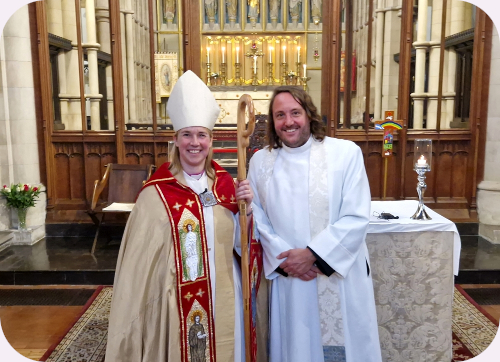
> Fr Corniel Quak with Bishop Jane of Hertford following his induction and licensing as Vicar of St John's, 20th June, 2024

SAFEGUARDING

 DONATE TO ST JOHN'S
DONATE TO ST JOHN'Swith ChurchSuite

PRAYER REQUEST

NEWSLETTER
Upcoming Services and Events
Sunday 21st December
The Fourth Sunday of Advent
10.30am - Parish Mass with Hymns
6.00pm - Carols by Candlelight
Monday 22nd December
8.00am - Morning Prayer
Tuesday 23rd December
5.30pm - Evening Prayer
Wednesday 24th December
Christmas Eve
10.00am - Said Mass with Lectio Divina
4.00pm - Crib Service
11.00pm - Midnight Mass
Thursday 25th December
Christmas Day
10.30am - Parish Mass with Carols
Sunday 28th December
The First Sunday of Christmas
10.30am - Parish Mass with Hymns
Join us at St John's over Christmas...click here to see our special Christmas services.


